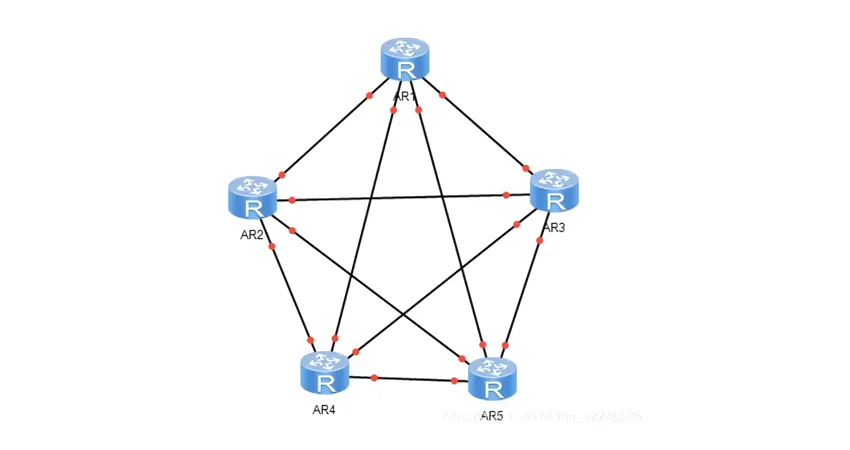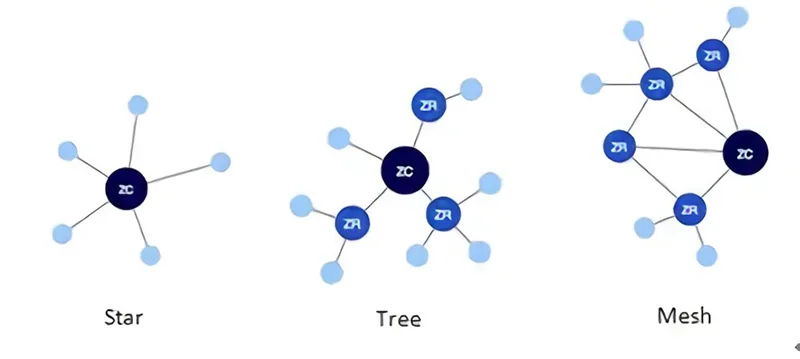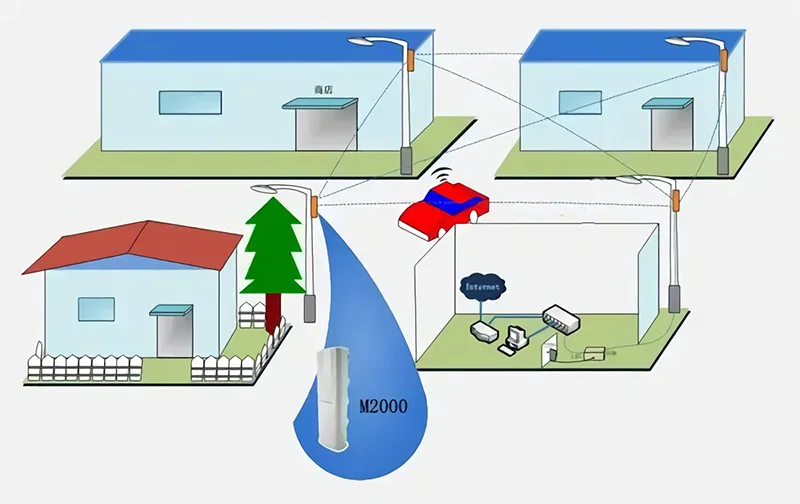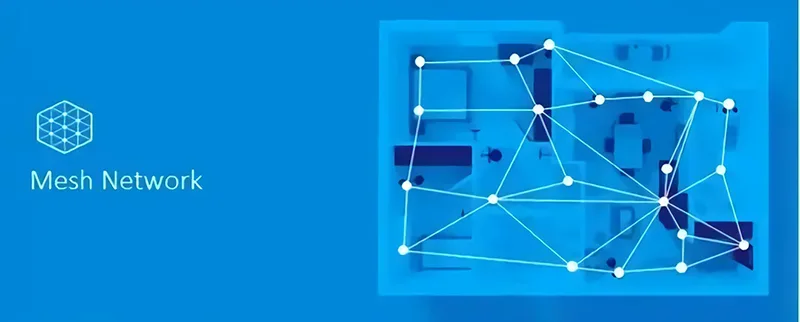Ein Mesh-Netzwerk ist eine Gruppe miteinander verbundener Geräte, Zum Beispiel, ein IoT-Gateway, das als ein einziges Netzwerk in Ihrem Raum fungiert, Ein Mesh-Netzwerk besteht aus mehreren Konnektivitätsquellen und nicht nur aus einem Gateway. Seit den 1960er Jahren, Die Netzwerktechnologie hat sich rasant entwickelt. Herkömmliches LAN hat 6 Arten von Anwendungsstrukturen, wie zum Beispiel die Bereitstellung von Struktur, Typstruktur, andere Typstrukturen, und so weiter. Sie agieren auf globaler Ebene, Bereitstellung von Datentechnologie und viel Stabilität. Heute, Wir stellen Ihnen die Technologie der Mesh-Netzwerke ausführlich vor.
1. Was ist Mesh-Netzwerktechnologie??

Die Entwicklung der Netzwerktechnologie hat große Veränderungen in der menschlichen Gesellschaft mit sich gebracht. Es hat den Menschen die Kommunikation erleichtert, bequemer für die Informationsübertragung, und trug sogar zur technologischen Revolution und zur industriellen Modernisierung bei. Die Entwicklung des Netzwerks vom frühen kabelgebundenen Netzwerk und militärischen Netzwerk zum aktuellen drahtlosen Netzwerk und Weitverkehrsnetzwerk hat die Kommunikationskosten zwischen Menschen erheblich gesenkt. Die Netzwerktechnologie ermöglicht es den Menschen, sofort über die Geschehnisse der Welt im Hinblick auf den globalen Handel und Handel informiert zu sein, und erkennt wirklich die Gleichheit des globalen Informationsaustauschs. Jedoch, Der von der traditionellen lokalen Netzwerktechnologie im Entwicklungsprozess gewählte Weg scheint heute aufgrund technischer Einschränkungen gewisse Engpässe und Einschränkungen zu haben. Der Weg zur Lösung dieses Problems besteht darin, „zur ursprünglichen Absicht zurückzukehren“ und sich dem Mesh-Netzwerk zuzuwenden, das ist, die Mesh-Netzwerkstruktur.
2. Was ist ein IoT-Mesh-Netzwerk??

Mesh-Netzwerk ist eine Methode der lokalen Netzwerktopologie. Es kombiniert die Nutzung von Infrastrukturknoten (wie zum Beispiel Brücken, Geräte, und Schalter) das sind direkt, dynamisch, und nicht hierarchisch verbunden, um Daten effizient zu und von Clients zu übertragen. Diese Art der Netzwerktopologie garantiert, dass kein einzelner Knoten auf die Datenübertragung angewiesen ist. Daher, wenn ein Knoten ausfällt, Das Netzwerk kann sich „selbst reparieren“ und Daten mithilfe von Algorithmen wie „Shortest Path Bridging“ umleiten. (SPB), die im IEEE 802.1aq-Standard beschrieben sind. Dies macht Mesh-Netzwerke zuverlässiger, wenn die Konnektivität von größter Bedeutung ist und einige Knoten versagen oder destabilisiert werden.
Ein Mesh-Netzwerk nutzt Flooding, oder Routing, eine Technik, die normalerweise mit einer Art von Daten einhergeht. Mit der Flutmethode, Jedes eingehende Paket wird über jede verfügbare ausgehende Verbindung zugestellt, außer der daraus resultierenden Verbindung. Verwendung von Routing-Techniken, Daten springen um andere Knoten herum, bis sie ihr Ziel erreichen, und wird dann an seinen Standort gesendet. Das Mesh-Netzwerk konfiguriert sich dann selbst, um sicherzustellen, dass kontinuierliche Verbindungen zulässig sind und Daten über nicht verfügbare Pfade umgeleitet werden. Wieder, Dadurch kann das Netzwerk den Standard an Zuverlässigkeit und Elastizität erreichen, den Organisationen, die von einem geringen Verbrauch profitieren möchten, dringend benötigen, IoT-Anwendungen mit niedriger Datenrate.
3. Wie funktioniert ein Mesh-Netzwerk??

Derzeit übernimmt SIG MESH die MESH-Netzwerktechnologie, die auf dem Flooding-Protokoll basiert.
Das Mesh-Netzwerk besteht aus Mobiltelefon und Knoten, Dabei ist Mobile ein Smartphone und dient als Steuerungsende des Mesh-Netzwerks.
Knoten ist ein Knotengerät im Netzwerk. Das BLE Mesh-Netzwerk wird durch Broadcasting implementiert. Die grundlegenden Schritte sind:
• A. Senden Sie Steuer- oder Lesedaten vom mobilen Endgerät an Knoten A.
• B. Die Nachricht wird von Knoten A gesendet.
• C. Wenn Knoten B die Nachricht von Knoten A empfängt, Es sendet die Nachricht von Knoten A.
• D. Analog dazu, Verwenden Sie die Infektionsmethode, um die Nachricht von zehn zu zehn zu verbreiten, damit alle Geräte im Funkbereich diese Nachricht empfangen können.
MESH führt außerdem eine spezielle Verschlüsselung der Daten im Netzwerk durch, um den Diebstahl von Netzwerkdaten durch Überwachung und Man-in-the-Middle-Angriffe zu verhindern.
4. Mesh-Netzwerkarchitektur

Grundlegende Netzwerktopologie
Die Grundstruktur des lokales Netzwerk Enthält Baumstruktur, Busstruktur, Sternstruktur, verteilte Struktur, und so weiter. Die Sternstruktur ist derzeit die am weitesten verbreitete. Die Vorteile dieser Struktur liegen in der hohen Pünktlichkeit, einfache Struktur, und einfache Verwaltung. Seine Nachteile sind eine geringe Zuverlässigkeit und höhere Kosten als bei anderen Strukturen. Die Sternstruktur nimmt die Mitte und den Knoten als Mittelpunkt, und andere Knoten sind mit diesem Mittelpunkt verbunden. Die Busstruktur hat eine relativ einfache Struktur und eine starke Erweiterbarkeit, Es hat jedoch den Nachteil, dass es schwierig zu warten ist und Fehler in der Zweigstruktur nur schwer zu finden sind. Die Busstruktur hat kein offensichtliches Zentrum, und jedes Netzwerkgerät ist an einen Bus angeschlossen. Für eine sicherere und effizientere Nutzung, derzeit, Die überwiegende Mehrheit der in Betrieb befindlichen kommerziellen LANs verwendet eine Kombination verschiedener Netzwerktopologiemuster, um die maximale Leistung des LAN sicherzustellen und Hindernisse zu vermeiden.
Typisches Mesh (Mesh-Netzwerk) Struktur
Wenn es um Mesh geht, es bedeutet „netto“, „Mesh“ oder „Mesh“. Es ist ganz einfach. Aus der Grundbedeutung von Mesh, Die Topologie eines Mesh-Netzwerks ist wie folgt: Alle darin enthaltenen Netzwerkknoten werden nacheinander zu einem vollständigen Netzwerk verbunden, und ein Knoten ist mit mindestens einem weiteren Knoten verbunden. Im Zeitalter eines begrenzten Netzwerks, Es ist sehr schwierig, das Netzwerk mit einem Mesh-Layout auf Basis des Netzwerkkabels zu realisieren. Im drahtlosen Zeitalter, ohne die Einschränkungen von Netzwerkkabeln und den Einsatz verschiedener neuer Technologien, Der Aufbau drahtloser Mesh-Netzwerke ist relativ einfach.
5. Drahtlose Technologie in Mesh-Netzwerken

Multi-Channel-Verhandlung
Wenn ein drahtloses Mesh-Netzwerk auf alle Arten von Kanälen zugreift, Die MP-Knoten im Netzwerk können nur einmal einen Kanal hören. Im Namen der Nutzung weiterer Kanäle, Die Knoten müssen dynamisch zwischen den verschiedenen verfügbaren Kanälen umschalten. Dies erfordert einen Koordinierungsmechanismus, um zwei Kommunikationskanäle sicherzustellen. Alle Knoten arbeiten auf demselben Kanal. Eine Möglichkeit, damit umzugehen, besteht darin, die Zeitleiste in Beacon-Abstände zu unterteilen, zu Beginn jeder Bakentrennung, Erstellen Sie ein Zeitfenster namens ATIM, und erfordern dies zu Beginn des ATIM-Zeitfensters, Alle Knoten im Netzwerk werden gezwungen, auf denselben Kanal umzuschalten. Im ATIM-Fenster, Der Knoten, der Daten senden muss, nutzt die Steuernachricht, um den Kanal mit dem Empfänger auszuhandeln.
Kanalzuordnung
Die Kanalzuweisungstechnologie wird hauptsächlich für die Verwaltung und Nutzung mehrerer Kanäle in einem mehrkanaligen drahtlosen Mesh-Netzwerk eingesetzt. Gleichzeitig wird eine gute Netzwerkkonnektivität gewährleistet, Es verringert die Wahrscheinlichkeit von Kanalkonflikten im Mesh-Netzwerk und verbessert die Netzwerkeffizienz. Im Gegensatz zur Multi-Channel-Verhandlungstechnologie, Die Kanalzuweisungstechnologie besteht darin, mehrere Kanäle in einem Mesh-Netzwerk aus der Richtung der Aufteilung der Kanalfrequenzressourcen zuzuweisen. Zum Beispiel, Für die Verbindung zwischen MPs ist ein Kanalsatz definiert, und ein weiterer Satz von Kanälen ist für die Verbindung zwischen MAP und MeshSTA definiert. Die Gruppenaufteilung ist ein häufig verwendetes Kanalzuweisungsschema für drahtlose Mesh-Netzwerke. Es unterteilt alle benachbarten Knoten beliebiger MP-Knoten in Stapel, und dann ernennt
Kanäle jeder Charge gleichmäßig zu; Die jeder Gruppe zugewiesenen Kanäle werden innerhalb der Knotenkollision-Nachbarschaft ausgewählt. Der am wenigsten genutzte Kanal wird zugewiesen und die Verbindung zwischen den Gruppen ist gewährleistet.
Netzwerkerkennung
Die Netzwerkerkennungstechnologie wird hauptsächlich zum Erkennen neuer Knoten und Nachbarknoten im Mesh-Netzwerk und zum Erstellen entsprechender Informationslisten verwendet. Die Netzwerkerkennung erfolgt größtenteils durch Listenpflege und Netzwerkscans. Netzwerkscan bedeutet, dass MP-Knoten im drahtlosen Mesh-Netzwerk ihre umliegenden Nachbarknoten überwachen, indem sie aktiv Beacon-Signale senden oder überwachen, während die Listenpflege das Netzwerk passieren soll. Die Informationen der beim Scannen gefundenen Nachbarknoten, die zum selben Mesh-Netzwerk gehören, werden der Liste hinzugefügt. Wenn festgestellt wird, dass der benachbarte Knoten neu ist, Dann kann das gesamte Netzwerk die Routing-Tabelle verwenden, um es zu erkennen.
Routenweiterleitung
Mesh-Verbindungen und Pathfinding bestimmen viele technische Merkmale und Vorteile drahtloser Mesh-Netzwerke. Die Nutzungseffizienz von Mesh-Verbindungen in Mesh-Netzwerken und die Leistung des Netzwerks hängen von der Gestaltung von Routing und Weiterleitung ab. Beim Entwerfen eines drahtlosen Mesh-Netzwerk-Routing-Protokolls, Es ist darauf hinzuweisen, dass, Erstens, Das Routing sollte nicht nur auf der „minimalen Hop-Anzahl“ basieren., Sie sollten jedoch eine Vielzahl von Leistungsmetriken umfassend berücksichtigen und nach einer umfassenden Bewertung eine Routing-Auswahl treffen. Zweitens, Es sollte eine Netzwerkfehlertoleranz gewährleistet sein. und ein starker Support kann umgehend ein fungibles Netzwerk auswählen, um eine Unterbrechung der Dienstbereitstellung zu vermeiden, wenn das drahtlose Netzwerk beendet ist. Drittens, Es ist notwendig, verkehrstechnische Technologien nutzen zu können, um einen Lastausgleich zwischen mehreren Straßen durchzuführen und die Nutzung der Systemressourcen zu maximieren. Viertens, Es ist erforderlich, MP und MeshSTA gleichzeitig zu unterstützen. Häufig verwendete drahtlose Mesh-Routing-Protokolle können sich auf die Routing-Protokolle des AdHoc-Netzwerks beziehen. Zu den typischen Routing-Protokollen gehört das Dynamic Source Routing Protocol (DSR), Destination Sequence Distance Vector Routing Protocol (DSDV), Temporärer Order-Routing-Algorithmus (TORA), und Ad-hoc-On-Demand-Distance-Vector-Routing-Protokoll (AODV), usw. DSR ist das gebräuchlichste Peer-to-Peer-Topologie-basierte reaktive selbstorganisierende Routing-Protokoll, Dies zeichnet sich durch die Anwendung einer aktiven Caching-Strategie und das Extrahieren von Topologieinformationen aus dem Quellrouting aus, und Routen durch Vergleich erstellen.
Mesh-Sicherheit
Der Single-Feature-Multi-Hop-Zugangspunkt von Mesh selbst soll seine einzigartige Sicherheit realisieren, die Verwaltung und Implementierung eines Mesh aus dem Netzwerk zu organisieren; jedes Ziel und jeder Bereich von Mesh-Knoten; Behindertenschutz. Zur Lösung dieser Sicherheitsprobleme wurde die Mesh-Sicherheitstechnologie vorgeschlagen.
Um diese Sicherheitsprobleme gezielt zu lösen, Es wird eine Mesh-Sicherheitstechnologie vorgeschlagen.
6. Anwendungsbeispiele der Mesh-Netzwerk-Technologie

• Kommunikation auf dem Schlachtfeld: Drahtlose Ad-hoc-Netzwerke sind aufgrund ihrer Eigenschaften ohne Netzwerkeinrichtungen die bevorzugte Technologie für die digitale Kommunikation auf dem Schlachtfeld, schnelle Bereitstellung, und starke Robustheit. Es kann auf dem Schlachtfeld eingesetzt werden, um Aufgaben wie die Überwachung befreundeter Truppen und Ausrüstung zu erledigen, Feindliche Streitkräfte und Geländeaufklärung, Bewertung der Kriegsschäden, Positionierung und Verfolgung, und Erkennung biochemischer Angriffe; Flottenkampfgruppen, die Kommunikation benötigen, können auch über mobile Ad-hoc-Netzwerke aufgebaut werden. Kommunikation, ohne auf terrestrische oder Satellitenkommunikationssysteme angewiesen zu sein. Neben Kriegen, In Friedenszeiten werden auch drahtlose Sensornetzwerke eingesetzt, um feindliches Eindringen durch die Klassifizierung und Analyse von Schall- und Vibrationssignalen zu erkennen, um den nationalen Sicherheitsschutz zu gewährleisten.
• Notfallkommunikation: Nach Katastrophen wie Erdbeben, Überschwemmungen, und schwere tropische Stürme. Feste Kommunikationsnetze können zerstört werden oder nicht mehr normal funktionieren. Für Notfallrettung und Katastrophenaufklärung, ein drahtloses Ad-hoc-Netzwerk, eine Netzwerktechnologie, die schnell bereitgestellt werden kann, ohne auf feste Netzwerkeinrichtungen angewiesen zu sein, ist nötig.
• Umweltüberwachung: ICHn Netzwerkszenarien wie Wildtierschutz, Bodenüberwachung, und atmosphärische Überwachung, Es gibt Probleme wie eine große Anzahl von Knoten, eine Vielzahl von Datentypen, eine riesige Datenmenge, und ein riesiger Überwachungsbereich. Mehrere Überwachungsknoten bilden ein drahtloses, selbstorganisierendes Netzwerk, um den Zweck zu erreichen, zu geringen Kosten ein großflächiges autonomes Netzwerk aufzubauen und dann über ein Gateway eine Verbindung zum öffentlichen Netzwerk herzustellen, um die Umgebung zu überwachen, ohne eine große Anzahl von Infrastrukturen einzurichten und zu warten.
• Weltraumentwicklung: Es ist eine unmögliche Aufgabe, die Infrastruktur im Weltraum vollständig abzudecken. Die vorhandenen Satellitenkommunikationsmethoden sind schlecht skalierbar und können den Bandbreitenbedarf ziviler Dienste nicht im großen Maßstab decken. Durch das drahtlose selbstorganisierende Netzwerk zwischen Knoten, kombiniert mit dem opportunistischen Routing-Modus Store-Carry-Forward, die mobile Kommunikationsfunktion im Prozess der Universumsentwicklung wird realisiert.
• Industrieller Bereich: In den Bereichen Kohlebergbau und Petrochemie mit brennbaren und explosiven Problemen, Mithilfe drahtloser Sensornetzwerke können Daten in gefährlichen Umgebungen gesammelt werden, und anormale Alarme können jederzeit erkannt werden, Dadurch wird die Reaktionsgenauigkeit und -geschwindigkeit in gefährlichen Situationen verbessert und die Zahl der Opfer verringert. . Zusätzlich, im Bereich der modernen Fertigung, Arbeiter von Produktionslinien bis hin zu komplexen Maschinen und Anlagen versuchen, entsprechende Sensorknoten zu installieren, um über den Betriebszustand der Geräte auf dem Laufenden zu bleiben, Erkennen Sie Probleme frühzeitig und beheben Sie sie rechtzeitig, Dadurch werden Verluste und Unfälle effektiv reduziert. Häufigkeit.
• Medizinischer Bereich: SSensornetzwerke in drahtlosen Ad-hoc-Netzwerken finden auch bestimmte Anwendungen in der Medizin und im Gesundheitswesen. So bietet der Arzt große Bequemlichkeit.
7. Vor- und Nachteile eines Mesh-Netzwerks

• Knotenverbindung: Jeder dieser Knoten im lokalen Netzwerk wird einzeln verkettet, um eine offensichtliche dezentrale Situation darzustellen, und jeder Knoten ist mit mindestens zwei anderen Knoten verbunden. Die APS bestanden alle aus drahtlosen Peer-to-Peer-Relay-Verbindungen, Erweiterung der drahtlosen „Hot Spots“ in herkömmlichen WLANs zu drahtlosen „Hot Pints“, die tatsächlich eine große Abdeckungsfläche erreichen.
• Selbstkonfiguration: Die APs im drahtlosen Mesh-Netzwerk erleichtern die Netzwerkverwaltung und -wartung durch ihre eigene automatische Konfiguration und zentrale Verwaltungsfunktionen.
• Selbstheilung: Der AP im drahtlosen Mesh-Netzwerk stellt durch seine eigenen Funktionen der automatischen Erkennung und Winter-Routing-Verbindung andere Pfade bereit, um die Auswirkungen eines einzelnen Fehlers auf Dienste zu beheben.
• Grosse Bandbreite: Es erweitert den drahtlosen „Hotspot“ im herkömmlichen WLAN zu einem drahtlosen „Hotspot“, der wirklich einen großen Bereich abdeckt, und verbessert das Original aufgrund der größeren WLAN-Entfernung und der langsameren Breitbandgeschwindigkeit. Zusätzlich, unter Verwendung des Mesh-Struktursystems, Das Signal kann Störungen durch Hindernisse im toten Bereich vermeiden und das Signal reibungslos übertragen.
• Hohe Auslastung: In einem Single-Hop-Netzwerk, Ein fester AP ist angeschlossen und wird von vielen Geräten genutzt, und die Verfügbarkeit des Kommunikationsnetzwerks des AP ist umgekehrt proportional zur Anzahl der Netzwerkgeräte. In einem Mesh-Netzwerk, Das Problem, dass die Verfügbarkeit des Kommunikationsnetzes des AP abnimmt, tritt nicht auf. Denn jeder Knoten des Mesh-Netzwerks ist ein AP, wenn die Verfügbarkeit eines der AP-Kommunikationsnetzwerke nicht verfügbar ist, Die Daten werden automatisch wieder mit dem neuen AP verbunden.
• Kompatibilität: Mesh verwendet das Standardformat 802.11b/g/n/ac, das weitgehend mit drahtlosen Client-Terminals kompatibel ist.
8. Ist ein Mesh-Netzwerk besser als WLAN??

Drahtloses Mesh-Netzwerk, wird auch als „Multi-Hop“-Netzwerk bezeichnet, ist ein neuer Typ drahtlose Netzwerktechnologie Das ist völlig anders als herkömmliche drahtlose Netzwerke, Ein drahtloses Mesh-Netzwerk ist eine neue Art von Netzwerkstruktur. Multi-Hop-Routing und Punkt-zu-Punkt-Netzwerktechnologie sind die Grundlage von Wireless Mesh. Es verfügt über die Besonderheiten des mobilen Breitbands. Zusätzlich, es ist in der Lage, sich dynamisch zu erweitern, selbstausgleichend, Selbstheilung, selbstverwaltend, und selbstorganisierende Netzwerke. Wireless Mesh ist in Bezug auf die Netzwerkmethode fortschrittlicher als Wi-Fi, Mobilität, und Übertragungsentfernung, und es hat auch die Eigenschaften von Wi-Fi.
daher, Das drahtlose Mesh-Netzwerk kann Wi-Fi bereitstellen und dabei helfen, die Übertragungsentfernung und Mobilität zu erhöhen, und bieten eine große Hilfe bei der Erweiterung von Wi-Fi-Anwendungen. Zusätzlich, basierend auf der derzeit beliebten Anwendung von Terminals, Wireless Mesh kann schnell durch Wireless Mesh gefördert werden. daher, Drahtlose Mesh-Netzwerke und Wi-Fi sind kompatibel und ergänzen sich gegenseitig.
In einem herkömmlichen drahtlosen lokalen Netzwerk (WLAN), wenn ein Benutzer kommunizieren möchte, Er muss sich zunächst mit einem festen Verbindungspunkt verbinden (AP), und jeder Benutzer muss sich mit der drahtlosen Leitung verbinden, die mit dem AP verbunden ist, um auf das Netzwerk zuzugreifen. Jump-Netzwerk. Im Gegensatz, Jeder drahtlose Geräteknoten im drahtlosen Mesh-Netzwerk kann gleichzeitig die Rolle eines Routers und eines AP spielen. Zwischen jedem Knoten ist eine direkte Eins-zu-eins- oder Eins-zu-viele-Kommunikation möglich, und jeder Knoten kann Signale senden und empfangen.
9. Die Entwicklungsgeschichte der Mesh-Netzwerktechnologie
In 2001, Inter und andere Hersteller schlugen zunächst die Mesh-Architektur für drahtlose Netzwerke vor, das zu Beginn des Experiments hauptsächlich als internes Netzwerk des US-Militärs genutzt wurde.
In 2003, Nortel Networks hat ein Punkt-zu-Punkt-System eingeführt W-lan plus Mesh-Ad-hoc-Netzwerkarchitektur und plant, diese in Zukunft mit traditionellen Telekommunikationsnetzwerken zu kombinieren, um ein ergänzendes nahtloses Roaming-Netzwerk zu bilden.
Seit 2004, Mesh-drahtlose Ad-hoc-Netzwerke wurden beim Aufbau breitbandiger Metropolnetze eingesetzt, insbesondere in den neuen „drahtlosen Breitbandstädten“ und beim Aufbau der Multi-Netzwerk-Integration in den letzten Jahren.
Ein Mesh-Ad-hoc-Netzwerk ist eine Art drahtloses lokales Netzwerk, das ist, ein Netzwerk mit Maschenstruktur, auch als „MulTI-Hop“-Netzwerk bekannt. In einem Mesh-Netzwerk, Alle Knoten sind mit einem von ihnen verbunden, Jeder Knoten verfügt über mehrere Verbindungskanäle, und alle Knoten bilden ein ganzheitliches Netzwerk, eine Technologie, die dynamisch neue Links erstellt, um sich mit anderen Knoten zu verbinden, es verfügt über Vernetzung. Zu seinen Vorteilen gehört die Skalierbarkeit, einfache und bequeme Vernetzung, und so weiter. Basierend auf diesen Vorteilen, Es kann die Kosten und Komplexität der Netzwerkbereitstellung für Benutzer erheblich reduzieren.
















